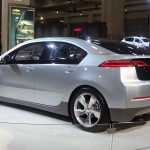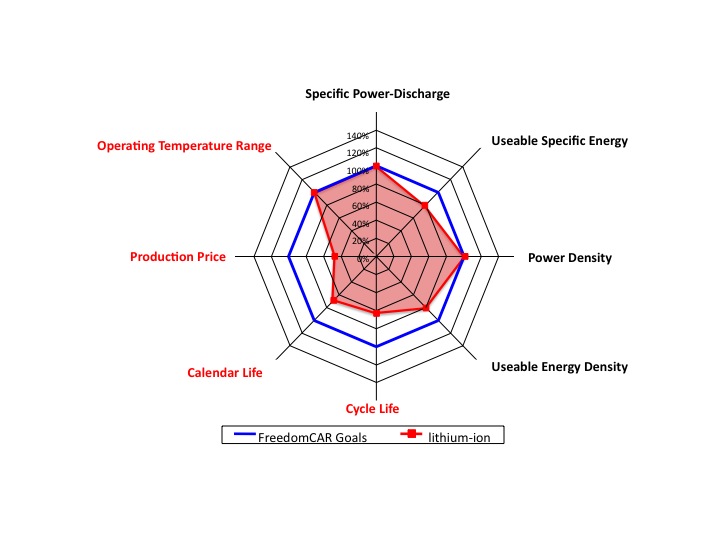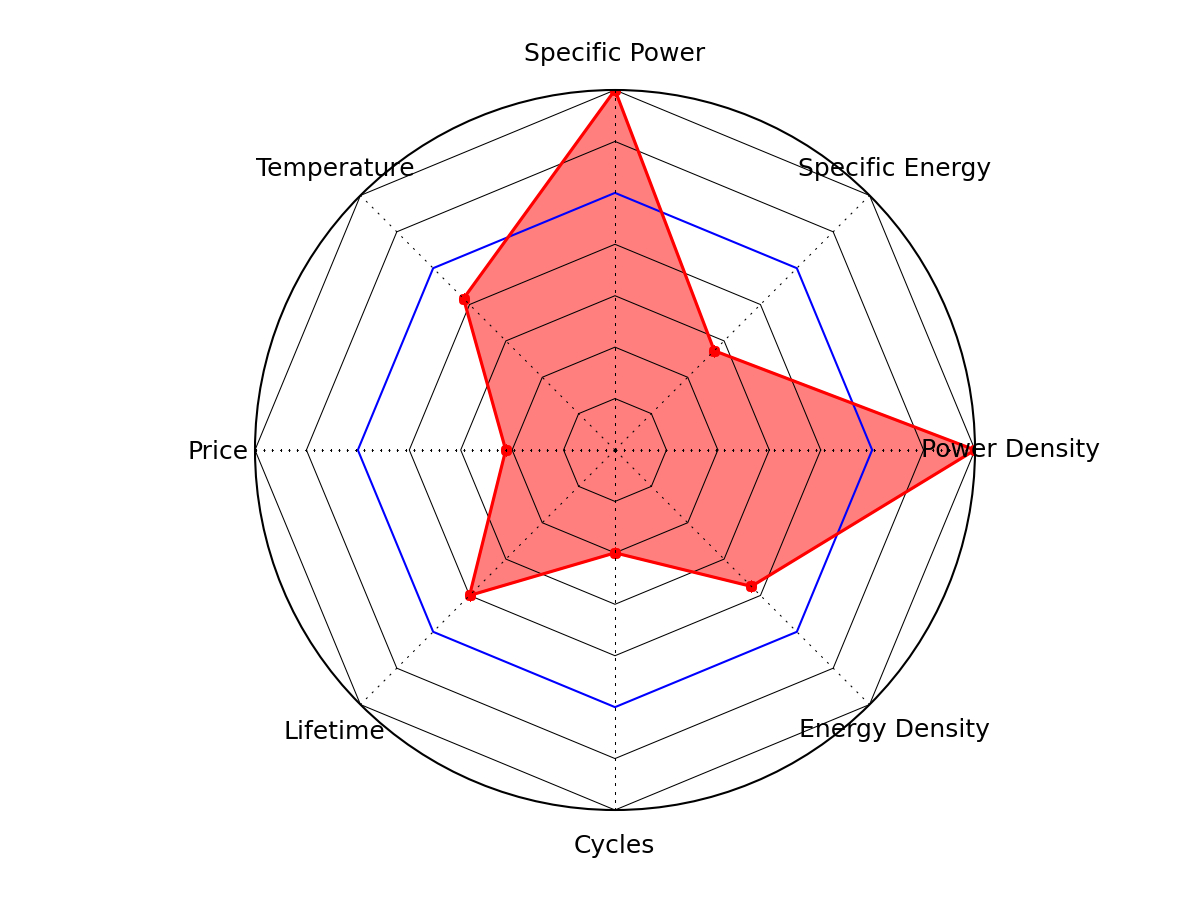Page added on August 31, 2012
Battery Performance Deficit Disorder

Batteries fail—as certainly as death and taxes. Rechargeable batteries at least offer the possibility of repeating the cycle, so are in this sense more like recurrent taxes than death. But alas, the story cannot repeat indefinitely. One cheerful thought after the other, yes? But wait, there’s more… Add to their inevitable demise an overall lackluster performance in battery storage technology, and we have ourselves the makings of a blog post on the failure of batteries to live up to their promises.
To set the stage, the specific energy of gasoline—measured in kWh per kg, for instance—is about 400 times higher than that of a lead-acid battery, and about 200 times better than the Lithium-ion battery in the Chevrolet Volt. We should not expect batteries to rival the energy density delivered by our beloved fossil fuels—ever.
A recent article in APS News reported on an emerging view that batteries are failing to live up to our dreams in the electric car realm:
Despite their many potential advantages, all-electric vehicles will not replace the standard American family car in the foreseeable future. This was the perhaps reluctant consensus at a recent symposium focused on battery research.
I was somewhat stunned to see this article. I am accustomed to seeing articles emphasizing the possible—albeit often improbable, in my mind. Also appearing in the article is a quote from Paul Alivisatos, an accomplished physicist, summarizing the need for further research:
“It remains true today, as in the past, that we need a fundamental understanding of the physics of how energy-conversion processes take place, at a much deeper level, in order to achieve a truly sustainable energy future.”
Rephrasing: the physics we currently understand is not sufficient to deliver the kind of battery we need to make the future work without fossil fuels. Red flags go up for me when it is our understanding of physics rather than practical engineering challenges standing in the way—as serious as the latter can be. Physics limitations instantly present a much taller order to overcome.
Anecdotes
I’m sure everyone has tales of how batteries have let them down—ranging from the merely annoying to life-threatening situations. I find that I am more often disappointed than pleasantly surprised when it comes to batteries. Here are some examples:
- I frequently go for months without driving my truck. The battery is often dead when I try to start it. Lead-acid batteries only get worse if left in a discharged state, so it’s a runaway process. Fortunately, I live on a hill and can often roll-start my way back onto the road.
- The rechargeable NiMh batteries I use for small electronics devices are rated for 1000 charge cycles. I’ll bet I only get about 15–20 cycles before noticing a serious degradation in performance.
- The first set of lead-acid batteries I used with my home-built solar photovoltaic system only lasted two years before showing substantially reduced capacity. A newer set is still in good shape after 2.5 years, but the drop in performance can be pretty fast, I have found.
- Lead-acid batteries for cars tend to last 5–6 years, often failing with little warning, in many cases resulting in being stranded.
- New laptop batteries seldom fail to delight their owners in how much longer the charge lasts compared to the previous generation batteries. But give it a few years and it is not uncommon to be operating at half the original capacity.
- Batteries left in a device for a long time can develop corrosive crud around the terminals, often in hard-to-clean places.
A counter-example is the occasional amazement I experience when alkaline batteries in a device that has not been utilized in years crackle to life after all that time—if the batteries haven’t gooped themselves up, that is.
Energy-Power Tradeoff
The chief measure of a battery, in my mind, is how much energy it can store. But it makes sense to adjust this concept to the size or mass of a battery. Obviously, a more massive and voluminous battery can pack in more energy. So for a given mass (we’ll take a kilogram), we want to know how much energy a battery can store, called specific energy.
At low power demand (sipping rather than gulping), lead-acid batteries tend to hold about 30–40 Wh per kilogram (one Watt-hour is equivalent to 3600 J, or 0.001 kWh of energy). Ni-MH batteries score 45–60 Wh/kg, and Lithium-ion gets about 120–180 Wh/kg. Part of the reason for Li-ion’s better performance is that lithium itself is lightweight; by volume lead-acid has about 40% the capacity of Li-ion. Gasoline, at 36.6 kWh/gal, has a specific energy of 13,800 Wh/kg. Off the charts!
As power demand increases, the battery flags, and will not offer as much total energy. Obviously, the battery discharges faster under heavier power demand, but the effect is exacerbated by less actual energy available. This is best shown on a Ragone plot, in which specific energy is plotted against specific power.

As useful as this plot is, it does not convey the whole story. While it looks like Li-ion meets the the goal for plug-in hybrid electric vehicles, this does not necessarily remain true if demanding 5,000 deep charge cycles, a ten-year lifetime, a moderately inexpensive product, etc.
Spider Diagrams
The U.S. Department of Energy teamed up with the automotive and battery industries to define benchmark performance targets for batteries that would result in electric vehicles being competitive with ICE vehicles on a mass-produced basis. The resulting coalition was called USABC/FreedomCAR, and their various target requirements are available here, with a useful summary presentation also available. Below is a subset of the target parameters pulled from these sources, and I have also thrown in the Chevrolet Volt for a side-by-side comparison to current capabilities.
Some of the figures for the Volt deserve explanation, since many cannot be directly looked up, and require inference and calculation. Firstly, the 2013 model battery pack has a capacity of 16 kWh, but only 10.5 kWh are made available so-as to avoid potentially damaging deep discharges. Meanwhile, I have no choice but to use the entire battery pack mass and volume (197 kg; 100 L) in conjunction with the partial 10.5 kWh charge in calculating energy densities, because available energy density is what’s important. For lifetime and cycle computations, I use the 100,000 mile, 8-year guarantee on the battery, together with the estimated 37 miles per gallon (MPG) on gas alone and 98 MPG for combined gas/electric. This implies an expectation that about 62,000 of the 100,000 miles will be driven under battery power. If recharges typically happen after 30 of the 38 miles are spent (corresponding to 80% of available capacity), this translates to about 2,000 deep cycles. Perhaps this is pessimistic in the sense that most guarantees correspond to a minimum expected performance. But offsetting this is the fact that the USABC targets are specified for end-of-life performance, whereas I use the beginning-of-life numbers for the Volt. General Motors estimates a 10–30% degradation at the end of 8 years (100,000 miles).
A comparison between actual performance and target performance can be cleverly displayed graphically in a “spider chart,” as illustrated below for the plug-in hybrid performance as of May 2011 (I first saw such diagrams in a presentation by Venkat Srinivasan, in 2008).


Full Cost of Electric Drive
Let’s say you pay $0.10 per kWh for electricity delivered to your home. Charging the Volt battery with 10.5 kWh at 90% efficiency to replace the drain from 38 miles of driving will cost $1.17. If using gasoline alone, the same car uses about a gallon of gas to go the same distance. Let’s put the cost of that gallon at $4.00. Electric looks pretty good, at these rates!
Now figure in the estimated price of the Volt battery at $8,000 (a disputed number, but GM has not revealed the actual cost). If we get 62,000 miles of electric drive out of the battery, we will spend $1950 on electricity for charging, plus $8000 for the battery. That’s $9,950. The same distance on gasoline would cost $6500. Not an order-of-magnitude difference, but still gasoline currently wins.
If the price of gasoline goes up (it will; but so will electricity), and the cost of the battery goes down (it should), the two may cross. But there are other added costs to the Volt (or hybrids in general) besides just the battery. After all, hybrids can’t jettison the ICE, and require an electric drive train to boot. Even the fact that the space occupied by the battery forces bucket seats in the back of the Volt is a “cost” that must be paid.
Beyond Cars
Batteries are, of course, useful for purposes other than transportation. While transportation hardship may be the most pressing problem in the decades following peak petroleum production, solar and wind resources cannot scale to be very large without a viable storage solution.
I worked out in an earlier post how large a lead-acid battery would have to be to support the entire U.S. energy demand in the presence of solar/wind intermittency. It turned out that our estimates for recoverable lead in the world do not satisfy the need. Lithium and Nickel are even more constrained. It is possible that some other approach like sodium-sulfer or zinc-air can step in. But these are already relatively well-known options and have not blazed a wide path into storage over the past few decades.
Sigh
Don’t get me wrong: even though I dwell on the shortcomings of batteries in this post, I still hold a net positive view. When it’s dark at my house, my refrigerator, television, computers, and internet goodies are all powered by stored sunlight in lead-acid batteries. My laptop battery gets me through many a bus ride and an occasional airplane ride. Batteries really do work, and provide value. Moreover, electric cars are more than a notion or fantasy: they are actually on the road getting people where they want to go. Despite their lackluster performance next to fossil fuel storage, batteries still beat the pants off of mechanical or gravitational storage.
And even though I might appear to be picking on the Chevy Volt by highlighting its deficiencies, I actually rather like the design point (electric vs. gasoline range hits the sweet spot, in my view). In fact, I was half way to buying one. By half way, I mean that if the price were cut in half, I would surely have one now.
The real point is that batteries fall pathetically short of our customary fossil fuel energy storage medium. When we wake up to a declining global availability of petroleum, we won’t just switch over to electric cars. We may not be able to collectively afford such a transition, given the huge up-front costs in both money and energy. Where will the prosperity come from? If oil shortages drive recession in the usual fashion, expensive options may be off the table.
Addendum
The same author of the APS article referenced above wrote an extended version, worth a look.
15 Comments on "Battery Performance Deficit Disorder"


Ken Nohe on Fri, 31st Aug 2012 1:36 am
Physics will not allow electric cars based on the model of gasoline cars? Well we can either change physics, a tall order or change the way we use cars.
We could/should standardize the battery packs and instead of recharging it at the gas station, just replace it with a full one while only paying for the charge + service.
This why you would pay once for the batteries and change it free of charge in a couple of minutes almost anywhere. Any store, more or less could sell you a “pack” if they are equipped to handle it. You would only have to pay again for the full value of a pack after 1,000 cycles as measured by the car.
But this imply social changes instead of technological changes although we are much better for the later than the former. And then there are all the frictions and interests against such a move which would no doubt hamper such a drastic change. It probably won’t happen.
And so we will struggle on. Hybrids will catch up slowly. Electric cars will remain toys for the wealthy and the eccentrics and gasoline cars will shrink in size as oil prices go up. This until a major crisis puts a full stop to the current paradigm and we can at last move to something new. Another few years though!
SolarDave on Fri, 31st Aug 2012 2:35 am
The next frog to be boiled will be gasoline vehicle range, which will decrease steadily as gas tank capacities shrink to reduce the weight of gas being carried in support of ridiculous (unneeded) range. The $100 fill-up will add to the momentum.
We’ll likely see the range curves ‘tween gas and electric cross within 5 years.
So say I 😉
DC on Fri, 31st Aug 2012 2:57 am
Batteries are like a great else we ‘produce’ these days. Disposable and designed to fail. Planned obsolescence is very alive and well in battery industry, and has been for nearly a century. The usual tiny incremental improvements that are dolled out to us dont change the basic method of battery production. Short-lived and disposable. Now to be sure, batteries do have real limitations , but our engineering is more than capable of producing much higher quality than we have now, but industry chooses not to, as our throw-away civilisation has not made durable long lasting batteries any sort of priority. But thats true of a great many other things as well.
You can see it in the industries backing of Li-on for EVs. A battery that still needs lots of ‘research’, and has the virtue of failing almost on schedule. Planned obsolescence as much as physics, or more so, determines the state of batteries
FarQ3 on Fri, 31st Aug 2012 3:05 am
Ken,
Can you imagine a self serve gas station with currently 8 fuel bowsers currently each servicing a vehicle every 5 minutes of the day. Say we changed this over to your ‘battery pack exchange model’ it would then require 8 cranes each requiring possibly two attendants. The ‘Battery Exchange Station’ would cater for 2304 vehicles a day. Where would all of these exchange battery packs be kept? Would the electricity supply authorities be willing to upgrade the local grid to supply the massive increase in electricity use in this centralised area? I can’t see this working at all in populated areas unless future battery packs weigh <20kg and are no bigger than todays average lead acid battery.
FarQ3 on Fri, 31st Aug 2012 7:06 am
General Motors Holden in Australia is advertising the ‘Holden’ Volt for $59,990 AUD. Somehow I think we Aussies are being totally ripped off ….
James A. Hellams on Fri, 31st Aug 2012 10:10 am
Folks, YOU HAVE IT ALL WRONG!
You are NEVER going to have a long distance electric vehicle, as long as you have the mentality of considering that only a car is an electric vehicle!
IF YOU REALLY WANT A LONG DISTANCE ELECTRIC VEHICLE, LOOK TO THE TRAIN!
Because every inch of track can be electrified, with THOUSANDS of miles of electric catenary; you TRULY have an ELECTRIC VEHICLE that can go THOUSANDS OF MILES ON ELECTRIC POWER! THIS IS DONE WITH NO RELIANCE ON BATTERIES!
GET IT INTO YOUR MINDS THAT AN ELECTRICALLY POWERED TRAIN IS AN ELECTRIC VEHICLE, TOO!
Ken Nohe on Fri, 31st Aug 2012 10:12 am
Unfortunately no. Engineers are not capable of making better batteries. The limits are physics not marketing. There are only so many ways to cram electrons and still be able to retrieve them on demand. Batteries is one area where we are doing surprisingly little progress. Another one is rocket engines. And unfortunately for both the prospects are not good: i.e. slow regular progress for as far as we can see. Fuel cells may one day become an alternative but the drawbacks and cost will prevent that from happening anytime soon.
This I believe is the message from the electric car that nobody wants to listen to. Sometimes there isn’t a technological solution. It isn’t just a matter of money or intelligence. It is just not possible. And because energy is so closely linked to basic physics, we often bump on these limits whenever we need energy. Think the lazer gun which can fit in your pocket.
And so we need to change our ways. Having a car which could run 500 miles on a tank of gas was great as long as gas was less than a few dollars per gallons. If we have to pay more than ten, which is almost the case now is Italy, it’s a different ball game and the gasoline suddenly becomes less attractive. What will replace it is hard to say but most probably a new way of using existing technology rather than a something completely new.
The electric car will not find an easy market in Arizona? fine enough. But then again I was flabbergasted to see how fast electric bikes took over the streets of China. In some cities ALL the bikes are electric now. Amazing. A mix of new laws, extreme pollution and slight technological changes did the trick. If it can happen there, it is possible anywhere. This alone should give us some hopes.
BillT on Fri, 31st Aug 2012 11:37 am
As mentioned above, battery swap is not going to happen. You couldn’t afford it even if the storage, handling and recharge could be worked out. Why?
1. The facility to accommodate that system would be expensive to build and maintain.
2. There are 100,000+ gas facilities in the US alone that would have to be retrofitted.
3. Hiring 30-40 new employees where there are zero now, with benefits.
4. Insurance to cover cars being damaged by a faulty or mishandled battery.
5. the chance of getting a worn out battery that lets you down 100 miles from the station you bought it from.
6. Each battery ‘refueling’ station would practically need their own power station.
I’m sure there are more reasons electric cars will never be more than toys. Dream on car addicts…
DC on Fri, 31st Aug 2012 12:12 pm
Agreed, battery-swapping is a stupid idea, to power an even dumber idea. The idea that in order to maintain our cherished notion that our own speed and convenience trumps all other considerations, well strip the entire world and empty of its remaining chemicals and metals required to build and maintain an impossible supply of standby battery packs at what…$10,000 a pop? And what for?, so we can get to Wall-mart faster than the other guy to save $3.00 on an electric hair-dryer. If you look at NEV’s, a form of electric personal transport im more friendly too, they do not incorporate ‘swapping’. They dont need it because the idea of using an EV to travel x-country to get from NY to disney-land is a retard idea to begin with.
Truth to told, its was a stupid idea for gas-burners too, but only a few people are starting to realize that it too, comes with a price tag thats becoming ever harder to bear, and fewer still talk about it publicly, but there you have it….
Ken Nohe on Fri, 31st Aug 2012 2:50 pm
Well, if everybody believes that battery swapping is a stupid idea, maybe it is. My point is not to promote this particular idea, just to say that the solution will come from changing our ways, not technology.
Here’s another idea: If we can’t swap batteries, we most certainly can swap the car itself. In fact we can go one step further: Why own a car at all? Why not swipe your card and use any car available? That would cost only a few dollars per trip. Can’t be done? Well, maybe difficult to implement in California but the idea is booming in Tokyo. Here for such a use suddenly, an electric car, even imperfect makes more sense. If you only need the car for 2 hours a day as many people do, why own the car?
Ken Nohe on Fri, 31st Aug 2012 3:02 pm
To this I know what people will answer: All the cars will be in one place in the morning and another one in the evening. If works with bicycles in Europe but only because you have trucks picking up the bicycles and transporting them were they are needed. Well, here the technology can help. A Google car should be able to drive itself back to were it is needed. Taxis for everyone without the cost. Who cares if they are electric or not?
SOS on Fri, 31st Aug 2012 7:19 pm
Nobody is going to use batteries or electric cars. All things considered, if you have a concern for the environment or conservation they have no less impact than any other fuel, are terribly expensive to own and operate, are difficult and expensive to manufacture and are limited by batterry technology that desperately needs a breakthrough despite billions in government aid.
The car is out there for you to buy if you want it. I dont think taxpayers are going to buy cars for the public at large. They are already kicking in about $75,000/volt.
There is no need for electric cars except in certain situations where people might think they are convenient.
I didnt see any mention of who will pay for the “free” cars?
SolarDave on Sat, 1st Sep 2012 2:30 am
I didnt see any mention of who will pay for the “free” cars?
Same folks who would otherwise pay for all that “free” drillin’ 😉
MrEnergyCzar on Sat, 1st Sep 2012 2:57 am
The batteries are fine as they are now. The 40 EV miles in my Volt has allowed me to only have to buy $105 in gas and electricity cost the first 12,000 miles of driving. (electricity is free from solar surplus at home and work charger).
340 mpg…
MrEnergyCzar
Ken Nohe on Sat, 1st Sep 2012 1:14 pm
Interesting. Here in Japan, the Prius has slowly become the nb one car in the street. But the distances are much lower than in the US and the speed lower too.